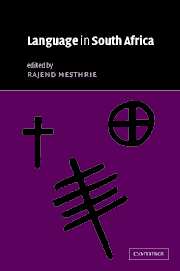Book contents
- Frontmatter
- Contents
- List of maps
- List of contributors
- Acknowledgements
- List of phonetic symbols
- List of abbreviations
- Introduction
- Part I The main language groupings
- 1 South Africa: a sociolinguistic overview
- 2 The Khoesan Languages
- 3 The Bantu languages: sociohistorical perspectives
- 4 Afrikaans: considering origins
- 5 South African English
- 6 South African Sign Language: one language or many?
- 7 German speakers in South Africa
- 8 Language change, survival, decline: Indian languages in South Africa
- Part II Language contact
- Part III Language planning, policy and education
- Index
- References
5 - South African English
from Part I - The main language groupings
Published online by Cambridge University Press: 22 September 2009
- Frontmatter
- Contents
- List of maps
- List of contributors
- Acknowledgements
- List of phonetic symbols
- List of abbreviations
- Introduction
- Part I The main language groupings
- 1 South Africa: a sociolinguistic overview
- 2 The Khoesan Languages
- 3 The Bantu languages: sociohistorical perspectives
- 4 Afrikaans: considering origins
- 5 South African English
- 6 South African Sign Language: one language or many?
- 7 German speakers in South Africa
- 8 Language change, survival, decline: Indian languages in South Africa
- Part II Language contact
- Part III Language planning, policy and education
- Index
- References
Summary
HISTORICAL BACKGROUND
Introduction
According to the 1996 census figures, English is the mother tongue of some 3.45 million people in South Africa. In terms of the old racial classifications, about 1.71 million of these are white, 0.58 million coloured, 0.97 million Indian and 0.11 million ‘African’. Broadly speaking, white, coloured and Indian English in South Africa are distinct ‘ethnolects’. This fact, however unpalatable its sociopolitical implications and however unsavoury its origins, is nevertheless historically significant. English was brought to this country from England, and was in its early days an instrument of English (= white by default) hegemony. Because of the education system then (as now), and the contingencies of inter-group relations, English must be seen primarily as a language that diffused from white European (specifically British) mother-tongue speakers to other communities.
The whole history, and the particular kinds of diffusion that occurred, have an important bearing on the structural properties of all varieties of English spoken in South Africa. Communities that shift from one language to another, whatever they ultimately make of the language shifted to when it becomes a mother tongue, are severely constrained by the properties of the input. To put it crudely but usefully, if South Africa had been settled mainly by Scots, and Scottish English had been the main input, and taught in the schools, all varieties of South African English (SAE) would now pronounce postvocalic /r/ (in far, mother), would not distinguish the vowels of foot and food, and would have three distinct vowels in bird, heard and word.
- Type
- Chapter
- Information
- Language in South Africa , pp. 104 - 126Publisher: Cambridge University PressPrint publication year: 2002
References
- 19
- Cited by

